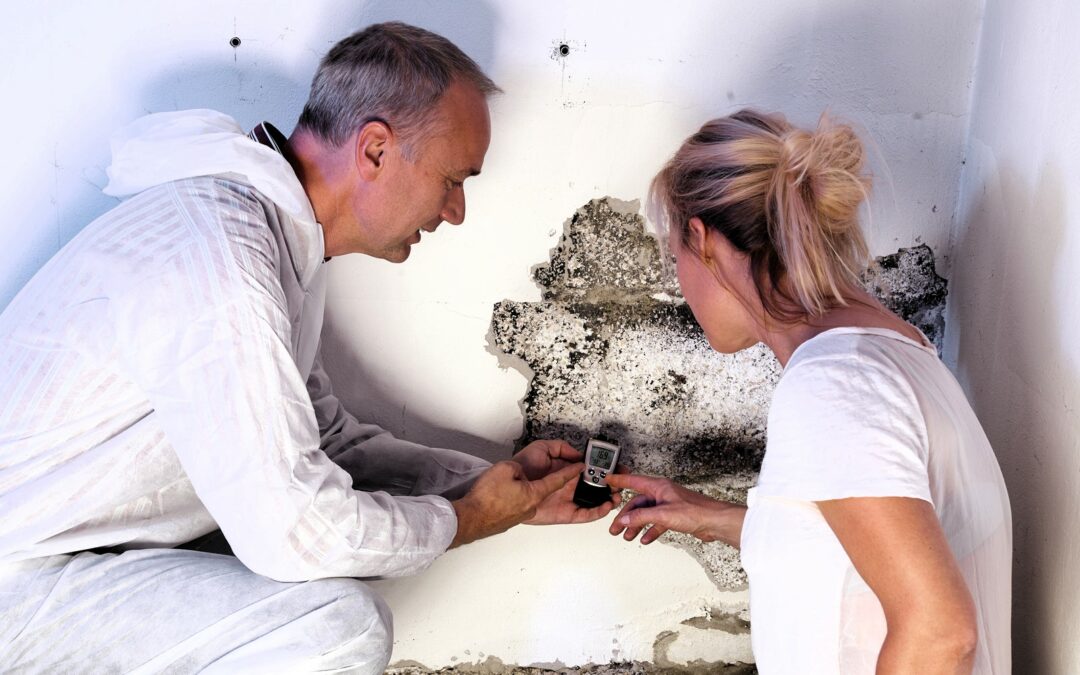Unveiling the Mold Remediation Process, T you Have to Know. Mold, a common problem in many homes, is more than just an unsightly nuisance; it poses significant health risks and requires professional remediation. Understanding the intricacies of the mold remediation process is crucial for homeowners to ensure their living spaces remain healthy and safe.
Mold remediation is a critical process involving specialized procedures to remove, clean, and disinfect mold-affected areas, ensuring complete eradication and prevention of future growth.
Understanding the Mold Remediation Process in Detail
Mold remediation is a comprehensive process that involves more than just the removal of visible mold; it’s an extensive approach to ensure a safe and healthy environment in your building. Let’s dive into the step-by-step procedure:
Initial Assessment and Isolation: The process begins with a detailed assessment by a Mold Removal Specialist (MRS), who examines the extent and source of mold. Critical at this stage is documentation for insurance purposes and isolating the affected area using plastic or polyethylene sheeting to prevent spore dispersal.
Safety Precautions: Mold remediation teams don protective gear – including respirators, goggles, and booties – to safeguard against mold spore inhalation, highlighting the potential health risks posed by mold.
Dust Suppression via Moisture: Contrary to what one might expect, a controlled addition of moisture is used to prevent mold spores from becoming airborne during remediation.
Removing Mold-Affected Materials: EPA-regulated removal of mold-infected building materials follows, with careful packaging, sealing, and disposal to prevent further contamination.
Thorough Cleaning: Non-removable materials undergo rigorous cleaning with specialized solutions, a meticulous process that can stir up spores, necessitating the disposal of non-disinfectable cleaning tools.
Restoring Contents: Modern content restoration techniques allow for the salvaging of many items, with a restoration company conducting an initial ‘contents pack out’ for off-site restoration.
Application of Biocides and Encapsulation: The space is treated with EPA-approved biocides, followed by an encapsulating product to prevent future mold growth, assuming the initial moisture problem is resolved.
Sanitization of Exit Areas: Post-remediation, the transition areas are sanitized using HEPA vacuums, ensuring any residual spores are eradicated.
Ensuring Complete Dryness: The final step involves thoroughly drying the area to the appropriate humidity level to preclude future mold growth.
Post-Remediation Clearance Testing: A comprehensive re-evaluation by a mold expert confirms the success of the remediation process, with tests for humidity, moisture, and airborne spores both inside and outside the treated area.
Effective Communication Throughout the Process
Keeping building occupants informed is crucial during mold remediation. It’s vital that building management communicates the extent of the mold issue and the remediation steps to be taken. Additionally, occupants should have access to inspection reports to stay informed about the status and safety of their environment.
In-Depth Remediation Strategies
Mold Area Isolation and Containment: The team isolates the mold area, sealing it off to prevent spore spread and using air filtration devices to maintain air quality.
Mold Removal and Disposal: Infested materials like drywall and carpeting are carefully removed and disposed of following safety guidelines to minimize spore dispersion.
Deep Cleaning and Disinfection: Surfaces are thoroughly cleaned with EPA-approved biocides, ensuring all mold residues are eradicated.
Post-Remediation Steps and Checks
Encapsulation and Final Treatments: Affected areas are encapsulated with paints or coatings to seal remaining mold spores and prevent regrowth.
Inspection and Verification: A thorough inspection follows to confirm complete mold removal.
Addressing the Source of Mold: Identifying and rectifying the root cause of mold, such as leaks or humidity issues, is crucial to prevent recurrence.
Utilizing Advanced Diagnostic Tools for Comprehensive Mold Detection
In the realm of mold remediation, the initial step of assessing the extent of mold presence is pivotal. Beyond mere visual inspections, professionals now leverage cutting-edge diagnostic tools such as infrared cameras, hygrometers, and moisture meters. These technologies allow for the detection of mold in hidden corners and behind structures, where it often thrives unseen. By accurately mapping out the moisture in building materials, these tools enable remediation experts to target their efforts more effectively, ensuring no mold colony is left behind. This precise identification is crucial for crafting an effective remediation strategy that addresses all affected areas.
Elevating Indoor Air Quality Management During Remediation
A cornerstone of successful mold remediation is the meticulous management of indoor air quality. To achieve this, remediation teams employ high-efficiency particulate air (HEPA) filtration systems, including air scrubbers and negative air machines. These devices work tirelessly to filter out mold spores from the air, not just within the quarantined zone but throughout the entire building. Such thorough air purification practices are essential for minimizing health risks and ensuring a safe environment for occupants post-remediation. This approach underscores the commitment to maintaining a healthy living space, free from airborne contaminants.
Embracing Eco-Friendly Remediation Methods for a Sustainable Approach
The evolution of mold remediation practices has seen a significant shift towards sustainability and environmental stewardship. Remediation experts now prioritize the use of eco-friendly cleaning agents and antimicrobials, which offer effective mold eradication without the harmful side effects associated with traditional chemicals. These green solutions are not only safer for the environment but also for the home’s occupants and pets. This transition reflects a growing recognition of the importance of sustainable practices in maintaining healthy indoor and outdoor environments.
Addressing the Psychological Impact with Empathy and Communication
The intrusion of mold can be a distressing experience for homeowners, fraught with concerns about health risks and property damage. Acknowledging this, mold remediation professionals adopt a compassionate approach, focusing on open communication and empathy. By providing regular updates, explaining the remediation steps in understandable terms, and offering reassurance, they help alleviate the stress and anxiety associated with the process. This empathetic engagement is invaluable in fostering trust and comfort for those affected, highlighting the human element in the technical process of mold remediation.
Offering Post-Remediation Support for Long-Term Mold Prevention
After the completion of the remediation process, the journey towards a mold-free home does not end. Professionals extend post-remediation support, guiding homeowners on best practices for preventing future mold outbreaks. This includes advice on maintaining appropriate humidity levels, ensuring adequate ventilation, and conducting periodic inspections of potential mold hotspots. Such ongoing support empowers homeowners with the knowledge and tools to safeguard their homes against mold, underscoring the remediation service’s commitment to lasting solutions and healthy living environments.
Crafting Customized Remediation Plans Tailored to Unique Situations
Understanding that each mold infestation is distinct, mold remediation experts devote significant attention to developing customized plans. These tailored strategies take into account the specific species of mold, the scale of infestation, and the unique characteristics of the affected building. This bespoke approach ensures that remediation efforts are not only efficient but also effective in addressing the particular challenges posed by each case. Through this meticulous planning, remediation services can achieve superior outcomes, restoring homes to their pristine, mold-free state with precision and care.
Understanding Mold Exposure and Its Health Implications
Mold in the environment can lead to various health issues, primarily through inhalation of spores, which can affect the respiratory system, skin, and eyes. People with allergies, asthma, or compromised immune systems are particularly susceptible to the effects of mold exposure. Symptoms can range from mild allergic reactions, such as sneezing, coughing, and skin irritation, to more severe health conditions like asthma attacks or respiratory infections. This section underscores the importance of addressing mold issues promptly to safeguard health and well-being.
The Science Behind Mold Infections
Mold infections, though less common than allergic reactions, can occur, especially in individuals with weakened immune systems. These infections can affect the skin, lungs, and other organs. The term “mold infection” typically refers to an invasion by mold spores into the body, leading to conditions such as fungal sinusitis, pulmonary aspergillosis, or dermatophytosis. Highlighting the distinction between allergic reactions and infections is crucial for understanding the full spectrum of health risks associated with mold exposure.
High-Risk Groups and Symptoms of Mold Infections
Certain individuals are at a higher risk of developing mold infections, including those with chronic lung diseases, undergoing chemotherapy, taking medication that weakens the immune system, or living with HIV/AIDS. Symptoms of a mold infection can vary widely depending on the area of the body affected but may include chronic cough, breathing difficulties, fever, skin rash, or sinus pain. This information is vital for readers to recognize potential health issues related to mold exposure and seek medical attention when necessary.
Conclusion
The mold remediation process is intricate, requiring professional expertise to ensure thorough removal and prevention of future growth. Homeowners should understand and trust this process for the health and safety of their living environments.
FAQ Section About Unveiling the Mold Remediation Process
Q1: Is it safe to stay in the house during mold remediation?
Generally, it is not advisable to stay in the house during extensive mold remediation due to potential health risks from airborne spores.
Q2: How long should you stay out of the house after mold remediation?
Post-remediation, a minimum of 24-48 hours is recommended, depending on the mold type and extent of treatment.
Q3: How long does a typical mold remediation process take?
The duration varies but generally takes between one to five days, contingent on the mold’s location, extent, and type.
Q4: How should you prepare your home for mold remediation?
Preparing involves clearing the area of personal items, ensuring pet safety, and providing access for the remediation team.
Q5: Can mold reappear after remediation, and how can it be prevented?
Mold can recur if underlying issues aren’t resolved. Regular inspections and moisture control are essential for prevention.


